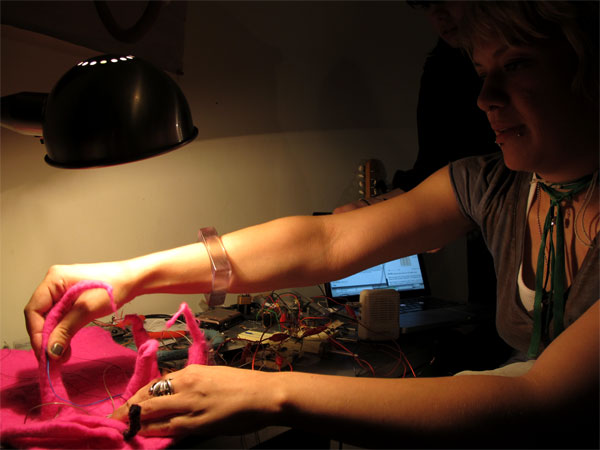
I met with sisters Sarah and Lara Grant of Felted Signal Processing the other week at their Brooklyn apartment. Felted Signal Processing is an ongoing project, which came out of their individual research as graduate students in NYU’s ITP program. Sarah entered the program to further her skills in new media and Lara went to learn how to program, play with hardware and generally learn the electronic side to apply to her interactive fashion. Now graduated, they have teamed together up in their Felted Signal Processing project, which allows them to explore their joint passion for soft circuitry and wearable technology. Together, they build colorful, handmade felt interfaces that allow users to manipulate sound through physical interaction such as pulling, scrunching or stroking. Most of their interfaces are built to output sound, but they are also interested in the development of new materials and techniques for fabricating soft sensors for interfaces that can be hooked up to a variety of outputs. Lara has been felting for 7 years, and they explained that felt is their “dream medium.” Sarah was the first of the two to apply the medium to soft circuitry; the name “Felted Signal Processing” actually came from her thesis, where she hacked a guitar pedal and integrated conductive felt into the circuit, letting users squeeze and scrunch the material in order to literally shape sound. Once Lara embarked on her thesis, she chose to develop a skill set of techniques to create and control variable resistance in soft circuitry. Sarah, a programmer with a background in new media art and a long standing interest in sound, focuses on the software and hardware side of their projects while Lara, who spent years working in fashion and textiles with an emphasis in conceptual, interactive design, handles the logistical side of interface and soft circuit design. They explained that once they start developing and producing their projects, they draw from their individual strengths and skill sets, where they share equal responsibilities and interests in all aspects of the projects creatively and technically.
The felt works as a variable resistor, meaning it doesn’t have fixed resistance and its conductivity can fluctuate when plugged into the circuit. In order to attain this property in soft circuitry, FSP designs with a variety of natural wools and metallic wools, as well as using conductive threads, yarns and fabrics. Merino wool is combined through with steel wool through a process called carding, in which the two materials are essentially combed together to achieve a blend. The material is then turned into durable textile by dry felting with barbed needles or by using a wet felting technique that involves hot water, soap, and pressure.
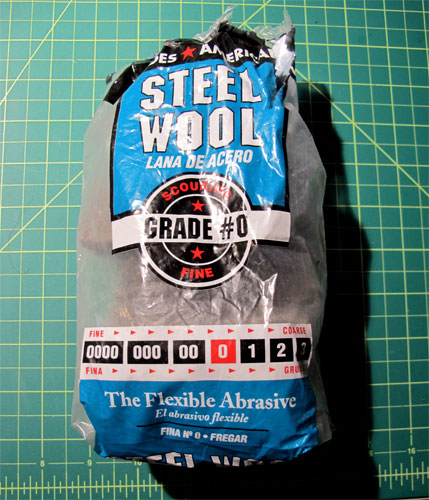
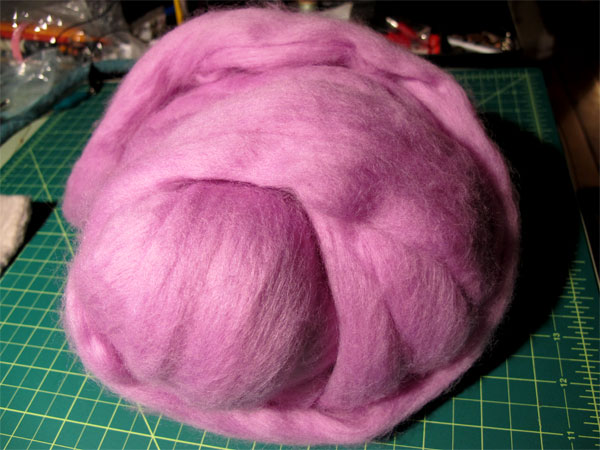

On the electronics side, Sarah and Lara breadboard all their circuits, making it easier for them to experiment. Once they find a stage in the circuit that they think would be interesting to let the user play with, they replace the hard resistor, capacitor or pot with the soft resistor, or the felt sensor, by connecting the textiles directly to the board.
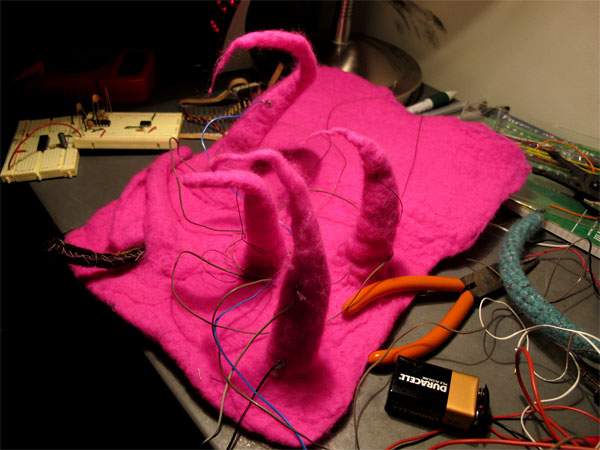
Sarah and Lara first showed me this pink interface, which I had also seen briefly at the ITP thesis show this past Spring. This pink interface uses a handmade stroke sensor, housed in the tendrils that are designed to invite people to pinch and stroke it. Each tendril is made of resistive and conductive thread stitched onto pieces of felt and embedded within the casing. There is more resistance at the bottom and less at the top, so pulling the tendril upwards increases the intensity of the sound, hooked up to a sound producing circuit. The tendrils also respond to pinching, where each pinch along its length locates a specific place on the linear path.
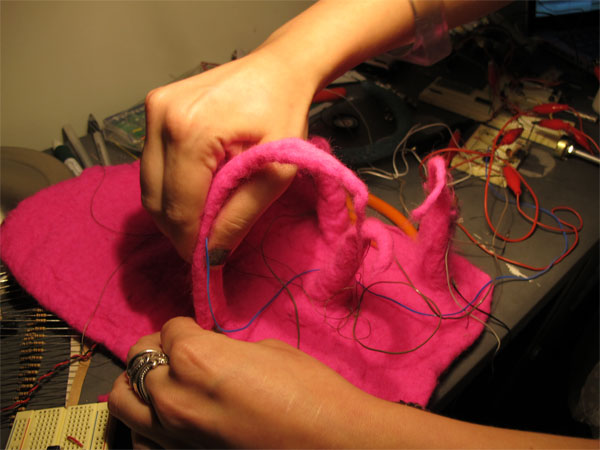
On the back of the felt square are alligator clamps that connect the signal from the circuits to an octave divider. The octave divider regulates the input frequency and outputs in various octaves, and this output is then plugged into the 555 timer, which makes basic square waves. This signal is then sent to a speaker, so you can hear it.

For their new project, they are building a quilt-like structure that will operate like one large modular analog synth. Sarah and Lara showed me one square of this structure.
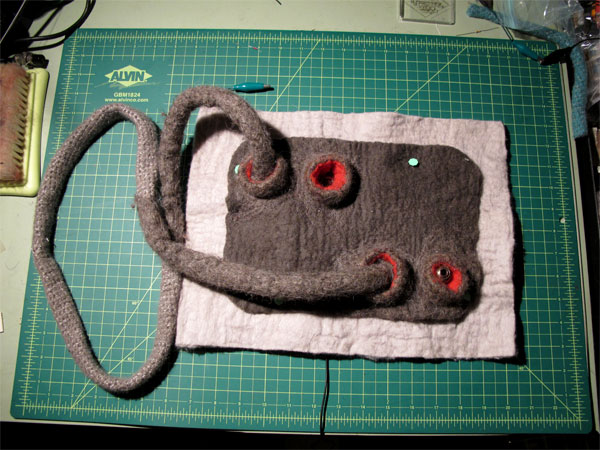
These patches represent one module, and work as one circuit. There is an input and output on both the top and the bottom, and a stretch sensor made of crocheted wool connects these two with snaps. The crocheted wool cord is a stretch sensor - meaning that if pulled or stretched, it regulates the frequency of electricity and therefore manipulates the sound. Like the tendrils on the pink square, it is a variable resistor.
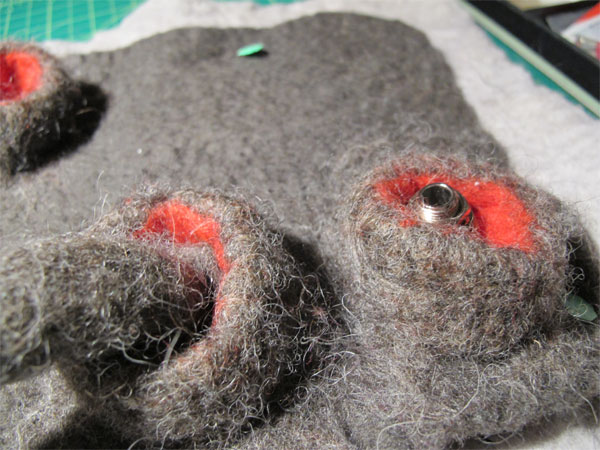

Once the project is complete, it will operate like a grid. There will be multiple patches like this - and the crocheted wool cords can be used to connect modules, shifting the sound around the grid. Additionally, as variable resistors, the cords themselves can be pulled and stretched to change the sound.
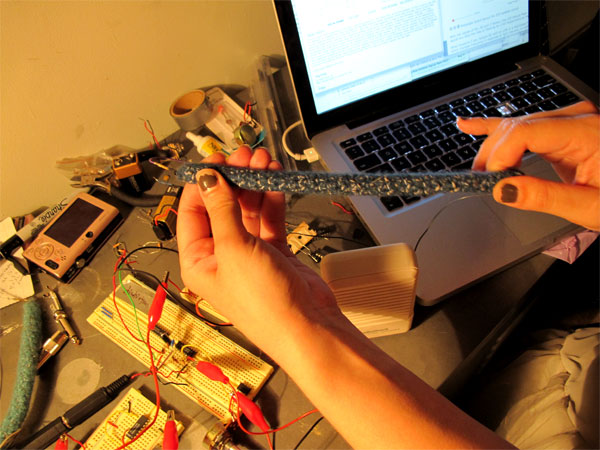
Lara also discussed the similarities between the DIY culture of felting and that of electronics. She hopes that these communities will pick up the techniques used in Felted Signal Processing, and towards this end, started putting tutorials online and is currently considering creating kits so that people can make their own soft circuits. For those who may want to learn soft circuitry in person, the Grants will be giving a workshop during the upcoming In/Out Fest happening on September 17th and 18th at the Tank in New York City. The subject of their workshop is textiles and electronics, and they will be teaching various techniques of soft circuitry while instructing participants on how to connect the textile to a circuit.
Thank you Sarah and Lara for the visit! Be sure to check their site for upcoming projects and announcements.


What a great idea, lots of potential.
How about a pair of pants that as you bend at the knees
open and close the wah or filter etc for guitar?!
The possibillities are endless!
I'll buy your first pair!
Best Regards,
Robert
that looks really great! i wish i saw this post earlier